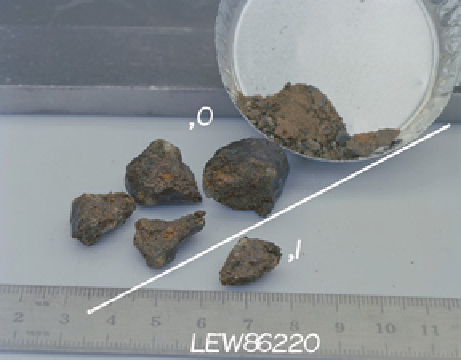Geology Reference
In-Depth Information
Acapulcoite
25.04 g
Found December 18, 1986
4.0 × 1.0 × 1.5 cm
Weathering = ?
and H chondrites, roughly chondritic mineralogies, achondritic, equigran-
ular textures, micrometer- to centimeter-sized veins of Fe,Ni-FeS that
cross-cut silicate phases, rapid metallographic cooling rates at ~600-400°C
(10
3
-10
5
°C/Myr) and trapped noble gas abundances comparable to type
3-4 ordinary chondrites. They likely formed from a precursor chondrite
that differs from known chondrites in mineral and oxygen isotopic
compositions. Heating to ~950-1000°C resulted in melting at the Fe,Ni-
FeS cotectic, but silicates did not melt. Silicate textures resulted from
extensive solid-state recrystallization. Acapulcoites share a common min-
eralogy, mineral composition, and oxygen isotopic composition with
lodranites and are believed to have originated on a common parent body.
4
Acapulcoites
Lodranites
LEW 86220
lAB Irons
IlICD Irons
Winonaites
Ureilites
Terrestrial mass
fractionation
3
2
IAB-IIICD-
Win
1
Ureilites
Aca-Lod
0
2
4
6
8
δ
18
O (‰)
Plate 39
MiNERALogy
SigNiFiCANCE
LEW 86220 is dominated by nickel-iron metal with a
0.3-1.2 mm diameter granular aggregate of olivine (Fa
7
),
pyroxene (Wo
2
Fs
9
), plagioclase (An
15
), and minor diop-
side (Wo
43
Fs
4
).
LEW 86220 is unique among the acapulcoite-lodranite
clan (left, [254]) in sampling a fine-grained, granoblastic
matrix cross-cut by a coarse-grained vein of pyroxene,
augite, metal, and sulfide. This remarkable juxtaposition
of lithologies likely formed when partial melts extracted
from the lodranite source region intruded into a slightly
cooler acapulcoite host and solidified. These remain our
only significant samples of the melts complementary to
the residual acapulcoites and lodranites.
References [252-259]




